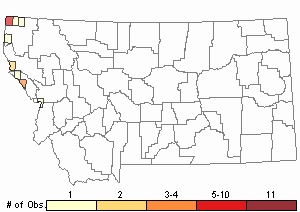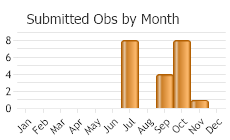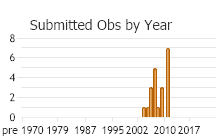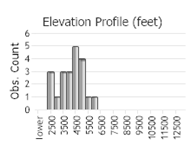View in other NatureServe Network Field Guides
NatureServe
Montana
Utah
Wyoming
Idaho
Wisconsin
British Columbia
South Carolina
Yukon
California
New York
Pale Jumping-slug - Hemphillia camelus
General Description
A moderately large slug of about 55 mm extended, but may reach 80 mm. As with all species of Hemphillia, the shell is partly exposed through a slit on the mantle about one-third its length, the mantle elevated into a visceral hump and sometimes covered with small bumps. Dorsal base color is pale cream-colored to golden-brownish or pale gray; head coloration is pale brown or cream centrally, sometimes with an irregular single grayish lateral stripe on each side; small irregular markings on the mantle form lateral stripes. Pneumostome is posterior to the midline of the mantle on the right side. The foot is somewhat narrow, with a median groove and tail pore near the posterior end, sometimes a low keel. The sides of the foot with a uniform series of indistinct oblique grooves covered with brownish or grayish patches that highlight a cream-colored or pale brown mid-dorsal stripe. The sole is undivided (not tripartite) and mucous can be milky in disturbed individuals. Sometimes responds to disturbance by thrashing the foot side to side and flipping themselves, hence the name jumping-slug (Hendricks 2012, Burke 2013). Internal anatomy is described in Pilsbry (1948). Originally described from animals taken at Old Mission, Kootenai County, Idaho.
Diagnostic Characteristics
A mantle elevated into a hump distinguishes this slug from all others in Montana except the Marbled Jumping-slug. The two species are similar, but the Pale Jumping-slug is generally pale to tan and has a pale mid-dorsal stripe on slightly broader tail that is lacking or indistinct in the darker brown to blackish Marbled Jumping-slug. The mantle may appear granular, but it lacks the small papillae found on the Marbled Jumping-slug.
Species Range
Montana Range
Range Descriptions

 Native
Native
Range Comments
Southeastern British Columbia, northeastern Washington, northern Idaho, and adjacent northwestern Montana west of the Continental Divide (Burke 2013). In Montana through 2009, 14 records in four counties: Lincoln (6), Mineral (5), Missoula (1), Sanders (2). Elevation range is 764 to 1920 m (2505 to 6300 ft). First reported from Montana in 2004. Originally described from animals taken at Old Mission, Kootenai County, Idaho. Up to eight individuals were found at a one Lincoln County site in early October (Hendricks 2012).
Observations in Montana Natural Heritage Program Database
Number of Observations: 21
(Click on the following maps and charts to see full sized version)
Map Help and Descriptions
Relative Density

Recency



 (Observations spanning multiple months or years are excluded from time charts)
(Observations spanning multiple months or years are excluded from time charts)
Migration
No information; relatively sedentary.
Habitat
Mostly in mesic mixed conifer forest, typically near water such as stream-side riparian areas and seeps. Canopy species include Western Redcedar, Western Hemlock, Engelmann Spruce, Subalpine fir, Grand Fir, Douglas-fir, alder, birch, and Black Cottonwood. Usually found under woody debris and leaf litter or in downed rotten logs, sometimes under rocks (Hendricks 2012).
Reproductive Characteristics
Hermaphroditic, based on internal anatomy (Pilsbry 1948). Copulation and egg-laying in the wild have been observed in late September, the eggs in clusters of 10-25 and opaque white. A captive individual laid eggs in mid-December (Hendricks 2012).
Stewardship Responsibility
Threats or Limiting Factors
Habitat occupied by Hemphillia camelus (low to moderate elevation mixed conifer forest, often in valley bottoms near water) is threatened by logging, grazing, fire, and possibly weed control and rural home development. The impact of fire retardant on this and other terrestrial mollusks is not known. Little is known about this species, including its sensitivity to disturbance.
References
- Literature Cited AboveLegend:
 View Online Publication
View Online Publication Hendricks, P. 2012. A Guide to the Land Snails and Slugs of Montana. A report to the U.S. Forest Service - Region 1. Montana Natural Heritage Program, Helena, MT. vii + 187 pp. plus appendices.
Hendricks, P. 2012. A Guide to the Land Snails and Slugs of Montana. A report to the U.S. Forest Service - Region 1. Montana Natural Heritage Program, Helena, MT. vii + 187 pp. plus appendices. Pilsbry, H.A. 1948. Land Mollusca of North America (north of Mexico), Volume II Part 2. The Academy of Natural Sciences of Philadelphia Monograph Number 2(2): 521-1113.
Pilsbry, H.A. 1948. Land Mollusca of North America (north of Mexico), Volume II Part 2. The Academy of Natural Sciences of Philadelphia Monograph Number 2(2): 521-1113.
- Additional ReferencesLegend:
 View Online Publication
View Online Publication
Do you know of a citation we're missing? Forsyth, R.G. 2004. Land snails of British Columbia. Royal British Columbia Museum: Victoria, British Columbia, Canada. 188 pp.
Forsyth, R.G. 2004. Land snails of British Columbia. Royal British Columbia Museum: Victoria, British Columbia, Canada. 188 pp. Frest, T.J. and E.J. Johannes. 2001. An annotated checklist of Idaho land and freshwater mollusks. Journal of the Idaho Academy of Science 36(2):1-51.
Frest, T.J. and E.J. Johannes. 2001. An annotated checklist of Idaho land and freshwater mollusks. Journal of the Idaho Academy of Science 36(2):1-51. Grimm, F.W., R.G. Forsyth, F.W. Schueler, and A. Karstad. 2009. Identifying land snails and slugs in Canada: introduced species and native genera. Canadian Food Inspection Agency, Ottawa, ON. 168 pp.
Grimm, F.W., R.G. Forsyth, F.W. Schueler, and A. Karstad. 2009. Identifying land snails and slugs in Canada: introduced species and native genera. Canadian Food Inspection Agency, Ottawa, ON. 168 pp. Hendricks, P., B.A. Maxell, and S. Lenard. 2006. Land mollusk surveys on USFS Northern Region lands. A report to the USDA Forest Service, Northern Region. Montana Natural Heritage Program, Helena, Montana. 11 pp. plus appendices.
Hendricks, P., B.A. Maxell, and S. Lenard. 2006. Land mollusk surveys on USFS Northern Region lands. A report to the USDA Forest Service, Northern Region. Montana Natural Heritage Program, Helena, Montana. 11 pp. plus appendices. Hendricks, P., B.A. Maxell, S. Lenard, and C. Currier. 2007. Land mollusk surveys on USFS Northern Region lands: 2006. A report to the USDA Forest Service, Northern Region. Montana Natural Heritage Program, Helena, Montana. 11 pp. plus appendices.
Hendricks, P., B.A. Maxell, S. Lenard, and C. Currier. 2007. Land mollusk surveys on USFS Northern Region lands: 2006. A report to the USDA Forest Service, Northern Region. Montana Natural Heritage Program, Helena, Montana. 11 pp. plus appendices. Hendricks, P., B.A. Maxell, S. Lenard, and C. Currier. 2008. Surveys and predicted distribution models for land mollusks on USFS Northern Region Lands: 2007. Report to the USDA Forest Service, Northern Region. Helena, MT: Montana Natural Heritage Program. 12 pp. + appendices.
Hendricks, P., B.A. Maxell, S. Lenard, and C. Currier. 2008. Surveys and predicted distribution models for land mollusks on USFS Northern Region Lands: 2007. Report to the USDA Forest Service, Northern Region. Helena, MT: Montana Natural Heritage Program. 12 pp. + appendices. Smith, A.G. 1943. Mollusks of the Clearwater Mountains, Idaho. Proceedings of the California Academy of Sciences, fourth series, 23:537-554.
Smith, A.G. 1943. Mollusks of the Clearwater Mountains, Idaho. Proceedings of the California Academy of Sciences, fourth series, 23:537-554.
- Web Search Engines for Articles on "Pale Jumping-slug"
- Additional Sources of Information Related to "Snails / Slugs"





